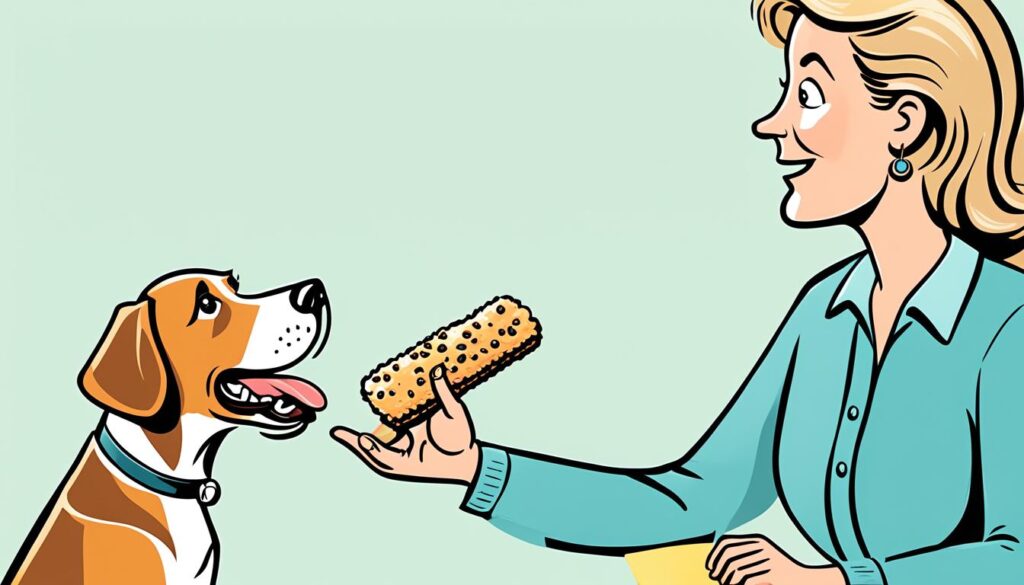Imagine the joy of coming home to a well-behaved, obedient, and happy dog. A four-legged companion who listens to your commands, walks calmly on the leash, and brings a smile to your face every day. As a dog owner, you understand the deep bond that forms between you and your furry friend. You want nothing more than to see them thrive, grow, and be the best version of themselves. That’s why learning how to train your dog effectively is not just a skill, but an act of love.
In this comprehensive guide, we will take you on a journey to uncover the most effective and simplified methods of dog training. Whether you are a new pet parent or an experienced dog owner, we have tips and techniques that will make the training process a joyous experience for both you and your canine companion.
Key Takeaways:
- Discover the power of positive reinforcement training
- Understand the basics of obedience training and puppy training techniques
- Learn essential commands that every dog should know
- Explore the benefits of clicker training
- Create a harmonious relationship with your dog through effective training methods
Understanding the Basics of Dog Training
The Fundamentals of Obedience Training
Before diving into the specific techniques of obedience training for dogs, it’s important to establish a solid foundation. Obedience training lays the groundwork for a well-behaved and obedient canine companion.
- Socialization: Introduce your puppy to various people, animals, and environments to ensure they grow up to be confident and well-adjusted.
- Positive Reinforcement: Reward your dog with treats, praise, and affection when they display desirable behavior, such as following a command or exhibiting good manners.
- Consistency: Establish consistent rules and expectations to avoid confusing your dog. Use the same verbal cues and hand signals for commands.
By implementing these fundamental principles, you can create a strong bond with your dog and provide them with clear guidelines for appropriate behavior.
Essential Puppy Training Techniques
Puppies are like sponges, eager to learn and explore the world around them. Harness their natural curiosity and energy with these essential puppy training techniques:
- Potty Training: Teach your puppy where to eliminate and establish a routine for regular bathroom breaks.
- Basic Commands: Begin with simple commands like “sit,” “stay,” and “come” to lay the foundation for future training.
- Bite Inhibition: Train your puppy to have a soft mouth and gentle play behavior by discouraging biting or nipping.
Remember, patience and consistency are key when training a puppy. Be sure to keep training sessions short and fun to avoid overwhelming your furry friend.
Successful House Training Techniques
One of the most essential aspects of dog training is house training. By following effective techniques, you can teach your dog good bathroom habits and maintain a clean and odor-free home. Here are some tips for successful house training:
- Establish a Routine: Take your dog outside to the designated bathroom spot at regular intervals throughout the day, such as after meals, naps, and playtime.
- Use Positive Reinforcement: Reward your dog with treats and praise when they eliminate in the appropriate area.
- Monitor and Supervise: Keep a close eye on your dog to prevent accidents inside the house. Utilize crate training or keep your dog in a confined area when unsupervised.
Consistency and patience are crucial during the house training process. Stay dedicated to the routine, and your dog will learn to do their business in the right place.

| Technique | Benefits |
|---|---|
| Consistency | Clear guidelines for your dog to follow |
| Positive Reinforcement | Encourages desired behavior and strengthens the bond with your dog |
| Routine | Establishes good bathroom habits for house training |
Understanding the basics of dog training, including obedience training, puppy training techniques, and house training, sets the stage for successful and effective training sessions. By laying this groundwork, you’ll be equipped with the knowledge and skills necessary to guide your dog towards good behavior and a harmonious relationship.
Positive Reinforcement: The Key to Successful Training
When it comes to dog training, positive reinforcement is undeniably the most effective method. This approach focuses on rewarding desired behaviors, using treats, praise, and other forms of positive reinforcement, leading to a joyful and successful training experience for both you and your furry friend.
Positive reinforcement training involves the use of rewards to reinforce the behaviors you want to see more of in your dog. This could be a tasty treat, a favorite toy, or simply showering them with praise and petting. By associating these rewards with the desired behaviors, you create an incentive for your dog to repeat them consistently.
“”Positive reinforcement is the cornerstone of successful dog training. When dogs are rewarded for doing something right, they learn faster and are motivated to continue improving.””
By using positive reinforcement, you create a strong and trusting bond with your dog. They learn to associate training sessions with fun and reward, rather than fear or punishment. This positive association not only boosts their confidence but also encourages them to engage in the training process willingly.
The Benefits of Positive Reinforcement Training
Positive reinforcement training offers numerous benefits for both you and your dog:
- Builds trust and strengthens the bond between you and your dog
- Creates a positive and joyful learning environment
- Enhances your dog’s confidence and self-esteem
- Reduces stress and anxiety during training sessions
- Encourages your dog to make the right choices independently
- Increases the likelihood of long-term behavior retention
With positive reinforcement, you can effectively teach your dog basic commands, address behavioral issues, and even tackle more advanced training tasks. It promotes a cooperative and mutually beneficial relationship, making training sessions enjoyable for both of you.
Combining Positive Reinforcement with Other Training Methods
Note that while positive reinforcement is highly effective, it’s essential to use it in conjunction with other training techniques to achieve the best results. Understanding your dog’s needs, setting clear expectations, and being consistent in your training approach are equally important factors for success.
Remember: Training should always be a positive experience, focused on rewarding good behavior and fostering a healthy bond between you and your dog.
| Key Features of Positive Reinforcement Training | Benefits |
|---|---|
| Uses rewards, treats, and praise to reinforce desired behaviors | Creates a positive and joyful learning environment |
| Builds a strong bond and trust between you and your dog | Enhances your dog’s confidence and self-esteem |
| Motivates your dog to engage willingly in the training process | Reduces stress and anxiety during training sessions |
| Increases the likelihood of long-term behavior retention | Encourages your dog to make independent, good choices |
Teaching Your Dog Essential Commands
Now that you have a solid foundation in dog training, it’s time to dive into the exciting world of teaching your furry friend essential commands. These commands will not only ensure your dog’s safety but also improve their overall behavior and obedience. From basic commands like sit and stay to more advanced skills like heel and fetch, this section will equip you with the step-by-step techniques to teach your dog various commands effectively.
Basic Commands
The first set of commands you’ll focus on are the basic commands that form the building blocks of your dog’s training. By mastering these commands, your dog will become more attentive, disciplined, and responsive. Here are some essential basic commands:
- Sit: Teach your dog to sit on command, which is useful for various situations, such as when you want them to greet visitors politely or take a break during walks.
- Stay: Train your dog to stay in one place until given permission to move. This command is vital for keeping your dog safe in potentially dangerous situations.
- Come: Teach your dog to come to you when called. This command is crucial for recall during walks or if your dog ever gets loose.
Consistency, patience, and positive reinforcement are key when training these basic commands. Remember to use treats, praise, and rewards to motivate your dog and make the learning experience enjoyable.
Advanced Commands
Once your dog has mastered the basic commands, you can move on to teaching them more advanced skills. These commands require a higher level of focus and obedience from your dog, but with the right approach, they can be easily learned. Here are a few advanced commands to consider:
- Heel: Train your dog to walk politely by your side without pulling on the leash. This command is beneficial for enjoyable and controlled walks.
- Fetch: Teach your dog to fetch and retrieve objects. This command is not only fun but also stimulates your dog mentally and physically.
- Leave It: Train your dog to ignore or let go of items that are potentially dangerous or off-limits. This command is essential for their safety.
As you progress to advanced commands, remember to break down the training into smaller steps and reward your dog’s progress along the way. Make the training sessions engaging and rewarding, ensuring your dog associates learning with positive experiences.

Command Training Tips
To make the training process smoother and more effective, consider the following tips:
- Use clear and consistent verbal cues for each command.
- Keep training sessions short and focused to maintain your dog’s attention span.
- Eliminate distractions during training to help your dog stay focused.
- Practice commands in various environments to generalize your dog’s training.
- Avoid punishment-based techniques and focus on positive reinforcement.
By following these tips and using the techniques outlined in this section, you’ll be able to teach your dog a repertoire of essential commands. Remember, training is a journey that requires time, patience, and dedication, but the bond and connection you develop with your dog along the way will make it all worthwhile.
| Command | Description |
|---|---|
| Sit | Teaches your dog to sit on command, promoting obedience and calm behavior. |
| Stay | Trains your dog to remain in one place until given permission to move, ensuring safety and control. |
| Come | Teaches your dog to come to you when called, promoting recall and responsiveness. |
| Heel | Trains your dog to walk politely by your side without pulling on the leash, promoting enjoyable and controlled walks. |
| Fetch | Teaches your dog to fetch and retrieve objects, providing mental and physical stimulation. |
| Leave It | Trains your dog to ignore or let go of items that are potentially dangerous or off-limits, ensuring their safety. |
Clicker Training: A Powerful Training Tool
Clicker training is a highly effective technique that can enhance your dog’s learning abilities. By using a clicker to mark desired behaviors, you can reinforce positive actions and accelerate the training process. This powerful tool creates clear communication between you and your furry friend, leading to quicker and more effective training sessions.
With clicker training, you’ll be able to establish a strong connection and understanding with your dog. Every time your dog exhibits a desired behavior, such as sitting or staying, you can use the clicker to mark the exact moment that behavior occurs. This instant feedback helps your dog associate the behavior with a positive outcome, making it more likely for them to repeat it in the future.
One of the biggest advantages of clicker training is its precision. Unlike verbal cues that may vary in tone or clarity, the clicker produces a consistent sound that your dog can easily recognize and associate with a reward. This makes it easier for your dog to understand the specific behavior they are being rewarded for, leading to faster learning and better results.
When introducing clicker training to your dog, it’s essential to pair the clicker sound with a reward, such as a small treat or praise. This positive reinforcement further strengthens the connection between the clicker sound and the desired behavior. Over time, your dog will learn to associate the clicker with positive experiences and will be motivated to engage in the desired behaviors.
Clicker training can be used to teach a wide range of commands and tricks, from basic obedience to advanced tricks like rollover or playing dead. The consistency and clarity provided by the clicker make it an excellent tool for shaping and reinforcing behaviors in a fun and rewarding way.
Remember to keep training sessions short and enjoyable for your dog. Clicker training should be a positive experience that strengthens the bond between you and your furry companion. Regular practice and patience will lead to impressive results, with your dog mastering new skills and behaviors in no time.
Discover the power of clicker training and unlock your dog’s full training potential.
| Benefits of Clicker Training |
|---|
| Enhances learning abilities |
| Improves communication between you and your dog |
| Encourages positive behaviors |
| Increases motivation during training sessions |
| Provides precise feedback |
Conclusion
In conclusion, mastering how to train your dog doesn’t have to be complicated. By utilizing positive reinforcement, understanding the basics, and implementing proven training techniques, you can create a harmonious relationship with your canine companion. Embrace the joy of training and witness the transformation in your dog’s behavior.
